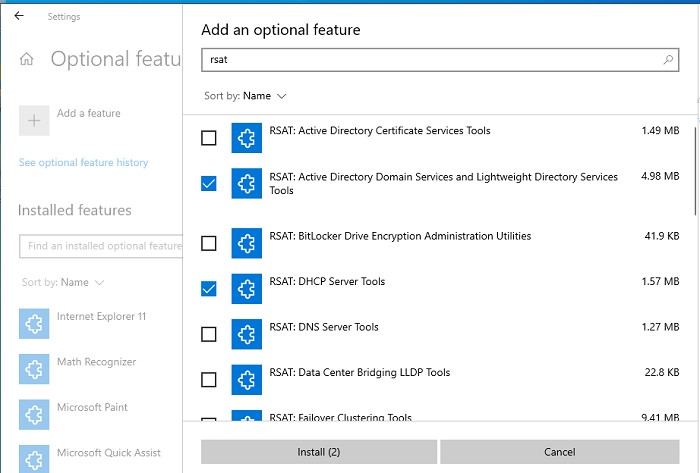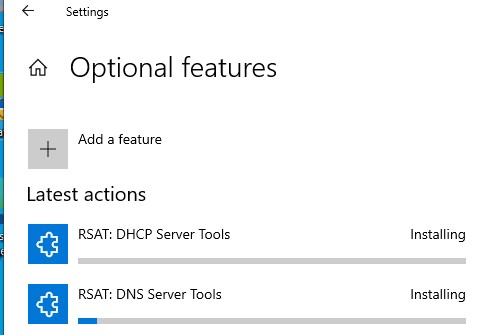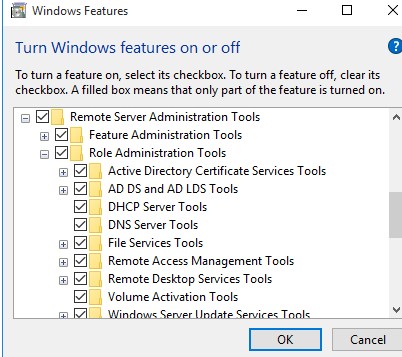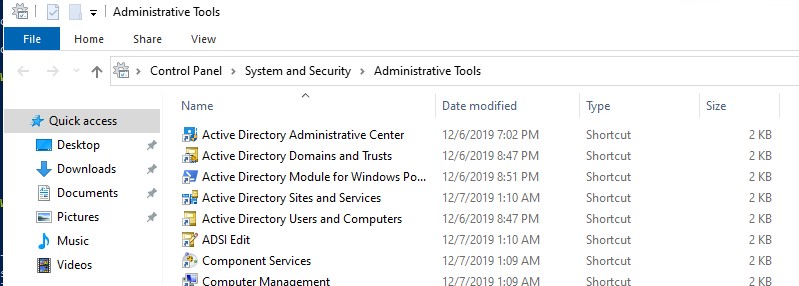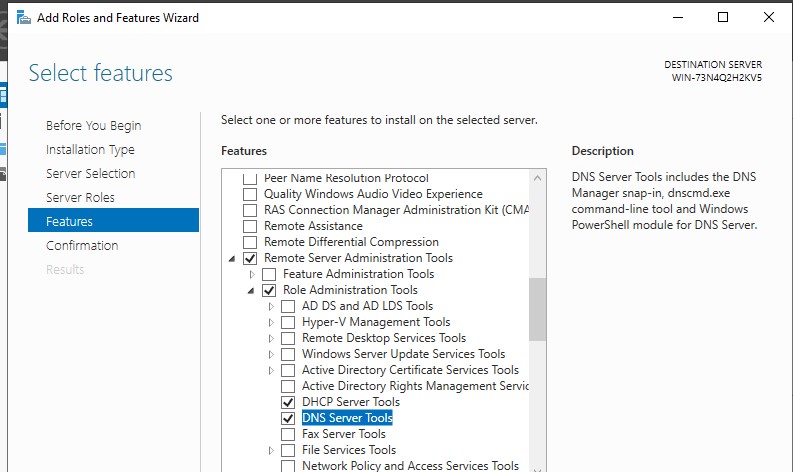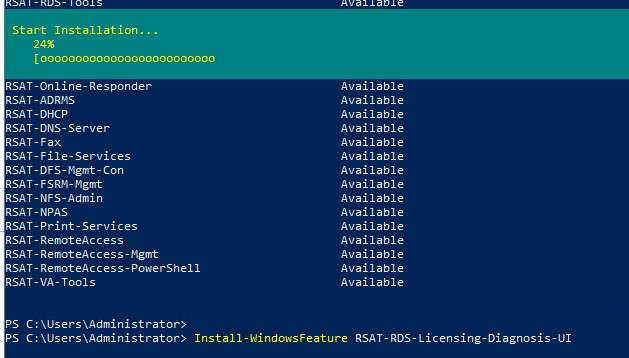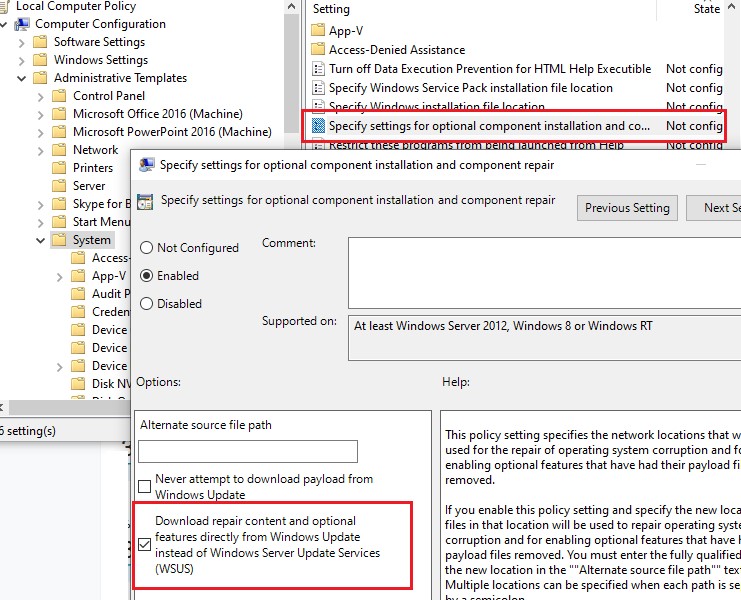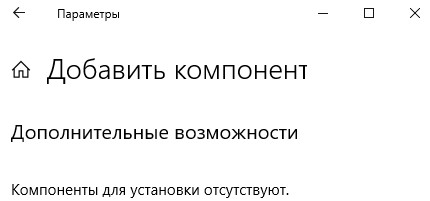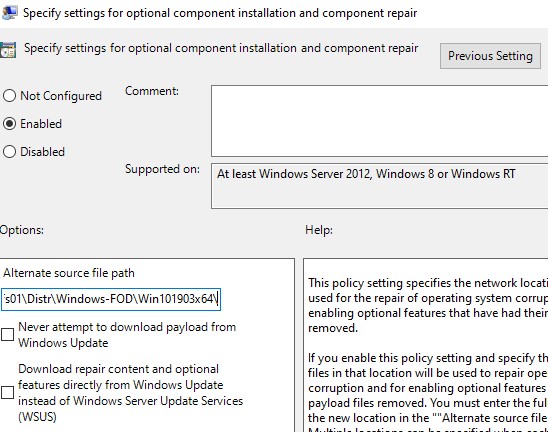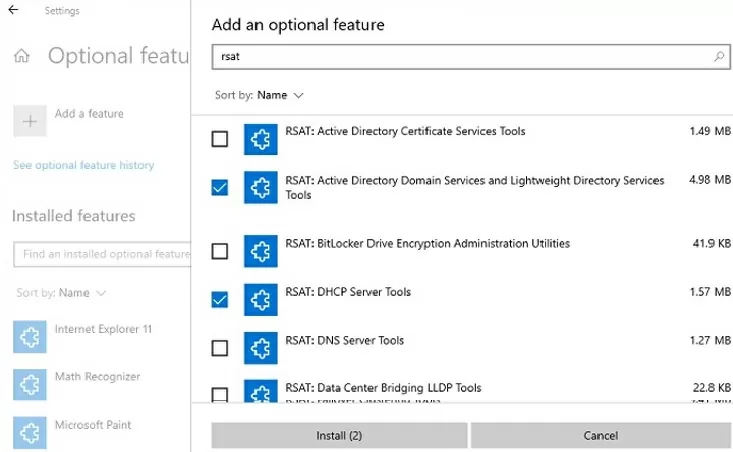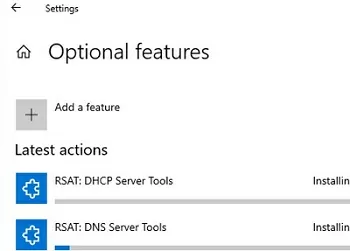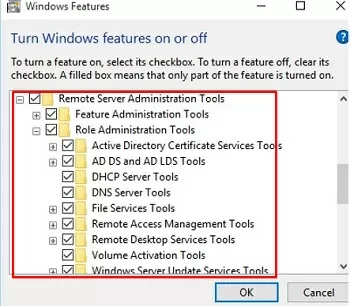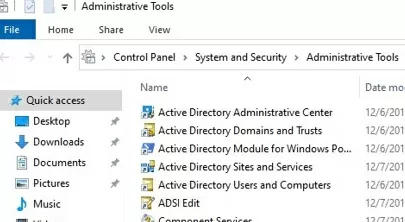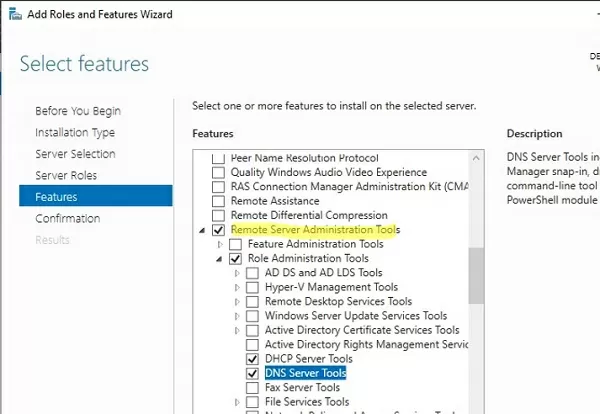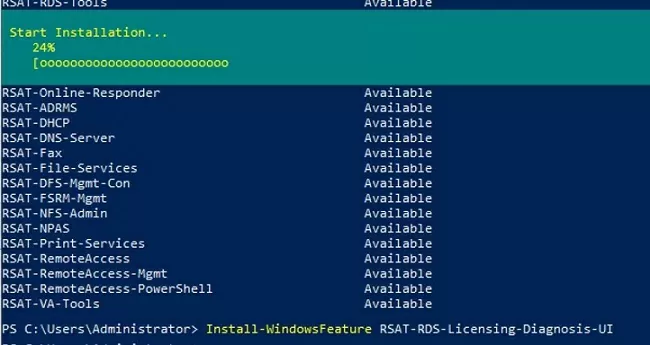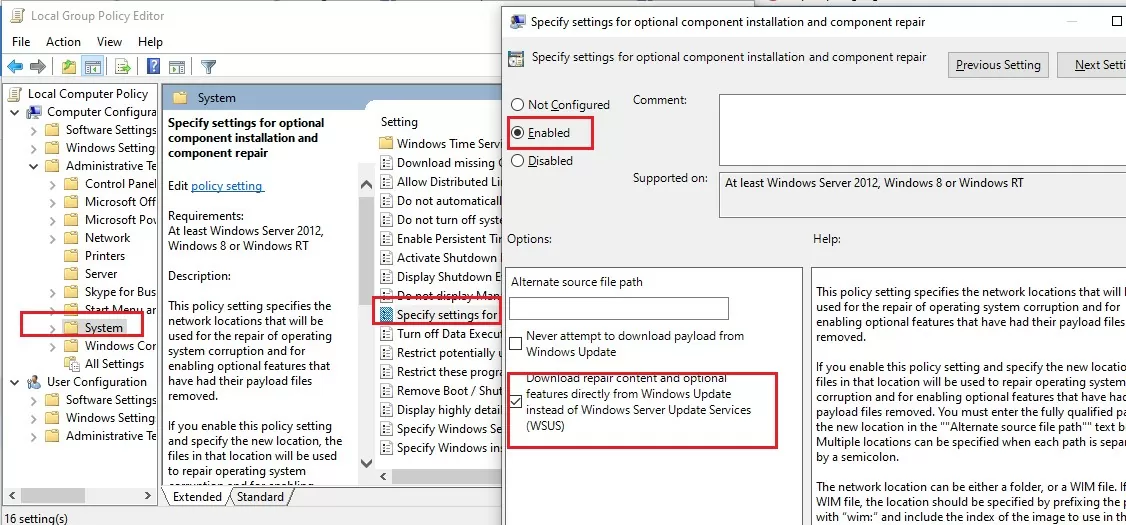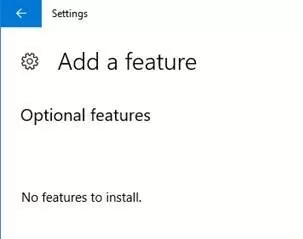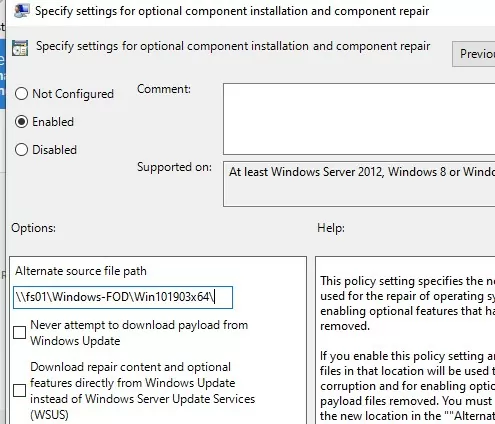Набор компонентов RSAT (Remote Server Administration Tools / Средства удаленного администрирования сервера) позволяет удаленно управлять ролями и компонентами на серверах Windows Server с обычной рабочей станции Windows. В RSAT входят графические MMC оснастки, утилиты командной строки, и модули PowerShell. Вы можете установить RSAT как на десктопных версиях Windows 10 или 11, так и в Windows Server 2022/2019/2016.
Содержание:
- Установка средств администрирования RSAT в Windows 10 и 11
- Установка RSAT в Windows с помощью PowerShell
- Как установить Remote Server Administration Tools в Windows Server 2022,2019,2016?
- Ошибка 0x800f0954 при установке RSAT в Windows
- Установка RSAT в Windows в офлайн режиме
Установка средств администрирования RSAT в Windows 10 и 11
В Windows 10 и 11 RSAT устанавливаются через графический интерфейс панели Settings -> Apps -> Optionla Features -> Add an optional feature (Параметры Windows -> Приложения -> Дополнительные возможности -> Добавить компонент).
Наберите в поисковой строке RSAT, чтобы вывести доступные компоненты. Вы можете установить в Windows 10/11 следующие инструменты администрирования RSAT:
- RSAT: Active Directory Domain Services and Lightweight Directory Services Tools
- RSAT: BitLocker Drive Encryption Administration Utilities
- RSAT: Active Directory Certificate Services Tools
- RSAT: DHCP Server Tools (настройка и управление DHCP сервером на Windows Server)
- RSAT: DNS Server Tools
- RSAT: Failover Clustering Tools
- RSAT: File Services Tools
- RSAT: Group Policy Management Tools – консоль управления GPO и PowerShell модуль GroupPolicy
- RSAT: IP Address Management (IPAM) Client
- RSAT: Data Center Bridging LLDP Tools
- RSAT: Network Controller Management Tools
- RSAT: Network Load Balancing Tools
- RSAT: Remote Access Management Tools
- RSAT: Remote Desktop Services Tools
- RSAT: Server Manager
- RSAT: Shielded VM Tools
- RSAT: Storage Migration Service Management Tools
- RSAT: Storage Replica Module for Windows PowerShell
- RSAT: System Insights Module for Windows PowerShell
- RSAT: Volume Activation Tools (консоль активации KMS сервера)
- RSAT: Windows Server Update Services Tools
Выберите нужные компоненты RSAT и нажмите Install.
Вы можете установить RSAT только Professional и Enterprise редакциях Windows 10/11, но не в Windows Home.
После установки некоторых компонентов RSAT может потребоваться перезагрузка.
Компоненты RSAT не включены в состав Windows, а поставляются в виде Функции по требованию (Features on Demand). Это значит, что для установки RSAT ваш компьютер должен быть подключен к интернету. Windows загрузит и установит необходимые файлы с серверов Microsoft Update.
В предыдущих версиях Windows (до билда Windows 10 1809) пакет удаленного администрирования серверов RSAT устанавливался в виде отдельного файла MSU обновления, которое нужно было вручную скачивать и установить с сайта Microsoft (https://www.microsoft.com/en-us/download/details.aspx?id=45520)
После установки пакета KB2693643 вы можете включить необходимые компоненты RSAT в разделе Control Panel -> Programs and Feature -> Turn Windows features on or off (
optionalfeatures.exe
). Разверните Remote Server Administration Tools и выберите необходимые компоненты для установки.
Если попытаться установить KB2693643 на более новых билдах Windows 10 или 11, появится ошибка:
Windows Update Standalone Installer encountered and error: 0x8024001d
После установки, графические mmc оснастки RSAT будут доступны в панели управления в секции Administrative Tools (Control Panel\System and Security\Administrative Tools) или в папке:
%ProgramData%\Microsoft\Windows\Start Menu\Programs\Administrative Tools
.
Установка RSAT в Windows с помощью PowerShell
Вы можете установить компоненты администрирования RSAT в Windows 10 и 11 с помощью PowerShell.
С помощью следующей PowerShell команды можно вывести список компонентов RSAT, установленных на вашем компьютере:
Get-WindowsCapability -Name RSAT* -Online | Select-Object -Property DisplayName, State
В нашем примере инструменты управления DHCP и DNS установлены (
Installed
), а все остальные модуль RSAT отсутствуют (
NotPresent
).
Для установки RSAT в Windows используется PowerShell командлет Add-WindowsCapability.
Чтобы установить конкретный инструмент RSAT, например инструменты управления AD (в том числе консоль ADUC из модуля Active Directory для Windows Powershell), выполните команду:
Add-WindowsCapability –online –Name Rsat.ActiveDirectory.DS-LDS.Tools~~~~0.0.1.0
Для установки консоли управления DNS и модуля PowerShell DNSServer, выполните:
Add-WindowsCapability –online –Name Rsat.Dns.Tools~~~~0.0.1.0
И т.д.
Add-WindowsCapability -Online -Name Rsat.BitLocker.Recovery.Tools~~~~0.0.1.0
Add-WindowsCapability -Online -Name Rsat.CertificateServices.Tools~~~~0.0.1.0
Add-WindowsCapability -Online -Name Rsat.DHCP.Tools~~~~0.0.1.0
Add-WindowsCapability -Online -Name Rsat.FailoverCluster.Management.Tools~~~~0.0.1.0
Add-WindowsCapability -Online -Name Rsat.FileServices.Tools~~~~0.0.1.0
Add-WindowsCapability -Online -Name Rsat.GroupPolicy.Management.Tools~~~~0.0.1.0
Add-WindowsCapability -Online -Name Rsat.IPAM.Client.Tools~~~~0.0.1.0
Add-WindowsCapability -Online -Name Rsat.LLDP.Tools~~~~0.0.1.0
Add-WindowsCapability -Online -Name Rsat.NetworkController.Tools~~~~0.0.1.0
Add-WindowsCapability -Online -Name Rsat.NetworkLoadBalancing.Tools~~~~0.0.1.0
Add-WindowsCapability -Online -Name Rsat.RemoteAccess.Management.Tools~~~~0.0.1.0
Add-WindowsCapability -Online -Name Rsat.RemoteDesktop.Services.Tools~~~~0.0.1.0
Add-WindowsCapability -Online -Name Rsat.ServerManager.Tools~~~~0.0.1.0
Add-WindowsCapability -Online -Name Rsat.Shielded.VM.Tools~~~~0.0.1.0
Add-WindowsCapability -Online -Name Rsat.StorageMigrationService.Management.Tools~~~~0.0.1.0
Add-WindowsCapability -Online -Name Rsat.StorageReplica.Tools~~~~0.0.1.0
Add-WindowsCapability -Online -Name Rsat.SystemInsights.Management.Tools~~~~0.0.1.0
Add-WindowsCapability -Online -Name Rsat.VolumeActivation.Tools~~~~0.0.1.0
Add-WindowsCapability -Online -Name Rsat.WSUS.Tools~~~~0.0.1.0
Чтобы установить сразу все доступные инструменты RSAT, выполните:
Get-WindowsCapability -Name RSAT* -Online | Add-WindowsCapability –Online
Также вы можете установить компоненты RSAT с помощью утилиты DISM:
DISM.exe /Online /add-capability /CapabilityName:Rsat.ActiveDirectory.DS-LDS.Tools~~~~0.0.1.0 /CapabilityName:Rsat.GroupPolicy.Management.Tools~~~~0.0.1.0 /CapabilityName:Rsat.WSUS.Tools~~~~0.0.1.0
Чтобы установить только отсутствующие компоненты RSAT, выполните:
Get-WindowsCapability -Name RSAT* -Online | where State -EQ NotPresent | Add-WindowsCapability –Online
Теперь убедитесь, что инструменты RSAT установлены (статус Installed);
Как установить Remote Server Administration Tools в Windows Server 2022,2019,2016?
В Windows Server для установки RSAT не нужен доступ в интернет. Компоненты RSAT можно устанавливать при установке соответствующих ролей или фич Windows Server, либо можно установить их через Server Manager (Add roles and Features -> Features -> Remote Server Administration Tools). Все компоненты RSAT разбиты на две секции: Feature Administration Tools и Role Administration Tools. Выберите необходимые компоненты и нажмите Next -> Next.
Для установки RSAT в Windows Server используется командлет установки компонентов и ролей — Install-WindowsFeature. Вывести список доступных компонентов RSAT в Windows Server 2022, 2019 и 2016:
Get-WindowsFeature| Where-Object {$_.name -like "*RSAT*"}| ft Name,Installstate
Для установки выбранного компонента RSAT, укажите его имя. Например, установим консоль диагностики лицензирования RDS:
Install-WindowsFeature RSAT-RDS-Licensing-Diagnosis-UI
Установить консоль удаленного управления Hyper-V Manager и PowerShell модуль Hyper-V:
Get-WindowsFeature | Where-Object {$_.Name -like "RSAT-Hyper-V-Tools"}| Install-WindowsFeature -IncludeAllSubFeature
Установленные графические консоли RSAT доступны из Server Manager или через панель управления.
Ошибка 0x800f0954 при установке RSAT в Windows
Если ваш компьютер Windows настроен на получение обновлений с локального сервера обновлений WSUS или SCCM (Configuration Manager) SUP, то при установке RSAT из графического интерфейса, Add-WindowsCapability или DISM вы получите ошибку.
В этом случае Windows будет пытаться загрузить пакет RSAT с вашего локального сервера обновлений и вернет ошибку 0x800f0954:
Чтобы игнорировать локальный WSUS при установке дополнительных компонентов Windows и Features On Demand (в том числе RSAT) нужно настроить специальный параметр групповых политики:
- Откройте редактор локальной GPO –
gpedit.msc
или используйте доменную консоль управления GPO –
gpmc.msc
); - Перейдите в раздел Computer Configuration -> Administrative Templates -> System;
- Включите политику Specify settings for optional component installation and component repair, и включите опцию Download repair content and optional features directly from Windows Updates instead of Windows Server Updates Services (WSUS) (опция “Скачайте содержимое для восстановления и дополнительные компненты непосредственно из Центра обновления Windows вместо использования службы WSUS”);
- Сохраните изменения и обновите настройки групповых политик (
gpupdate /force
). - Перезапустите службу Windows Update:
net stop wuauserv
net start wuauserv
Теперь установка RSAT через PowerShell или DISM должна выполняться без ошибок.
Некоторые параметры реестра могут блокировать подключение к Microsoft Update при получении компонентов RSAT. Если при установке RSAT появляется ошибка 0x8024002e, измените значения следующий параметров реестра в ветке
HKLM\SOFTWARE\Policies\Microsoft\Windows\WindowsUpdate
:
- DoNotConnectToWindowsUpdateInternetLocations = 0
- DisableWindowsUpdateAccess = 0
Затем перезапустите службу wuauserv.
Установка RSAT в Windows в офлайн режиме
Если вы не можете открыть прямой доступ с рабочей станции к серверам Microsoft Update, вы можете воспользоваться офлайн установкой RSAT (рекомендуется для корпоративных сетей без прямого доступа в Интернет).
Для офлайн установки RSAT нужно скачать ISO образ диска с компонентами FoD для вашей версии Windows 10/11 с сайта Microsoft или из личного кабинета на сайте лицензирования Microsoft (Volume Licensing Service Center, VLSC):
- Для Windows 10 2004 — https://learn.microsoft.com/en-us/azure/virtual-desktop/language-packs (FOD Disk 1 ISO)
- Для Windows 11 21H2/22H2- https://learn.microsoft.com/en-us/azure/virtual-desktop/windows-11-language-packs (Language and Optional Features ISO)
Например, для Windows 10 2004 x64 нужно скачать образ 19041.1.191206-1406.vb_release_amd64fre_FOD-PACKAGES_OEM_PT1_amd64fre_MULTI.iso (около 5 Гб). Распакуйте образ в сетевую папку. У вас получится набор *.cab файлов, среди которых есть компоненты RSAT.
Теперь для установки компонентов RSAT на рабочей станции Windows нужно указывать путь к данному сетевому каталогу с FoD в параметре -Source:
Add-WindowsCapability -Online -Name Rsat.ActiveDirectory.DS-LDS.Tools~~~~0.0.1.0 -LimitAccess -Source \\msk-fs01\Distr\Windows-FOD\Win101903x64\
Также вы можете указать путь к каталогу с компонентами FoD с помощью указанной выше групповой политики. Для этого в параметре Alternative source file path нужно указать UNC путь к каталогу с файлами FoD.
Или можете задать этот параметр через реестр отдельной политикой, указав путь к каталогу в параметр LocalSourcePath (тип REG_Expand_SZ) в ветке реестра HKLM\SOFTWARE\Microsoft\Windows\CurrentVersion\Policies\Servicing.
После этого, пользователи смогут самостоятельно устанавливать компоненты RSAT через графический интерфейс добавления компонент Windows 10.
Частые ошибки установки Remote Server Administration Tools в Windows
- 0x8024402c, 0x80072f8f – Windows не может поучить доступ к серверам обновления Windows для получения компонентов RSAT. Проверьте доступ в интернет или установите компоненты из локального образа FoD:
Add-WindowsCapability -Online -Name Rsat.Dns.Tools~~~~0.0.1.0 -LimitAccess -Source E:\RSAT\ - 0x800f081f – проверьте путь к каталогу с компонентами RSAT, указанному в параметре –Source;
- 0x800f0950 – ошибка аналогична 0x800f0954;
- 0x80070490 –проверьте целостность образа Windows с помощью DISM:
DISM /Online /Cleanup-Image /RestoreHealth
Windows OS Hub / Windows 10 / How to Install Remote Server Administration Tools (RSAT) on Windows
The Remote Server Administration Tools (RSAT) allow you to remotely manage roles and features on Windows Server hosts from a Windows workstation. RSAT includes graphical MMC snap-ins, command line tools, and PowerShell modules. RSAT can be installed on Windows Server 2022/2019/2016 as well as on the desktop editions of Windows 10 or 11.
Contents:
- Installing RSAT Tools on Windows 10 and 11
- Use PowerShell to Install Remote Server Administration Tools (RSAT) on Windows
- How to Install Remote Server Administration Tools on Windows Server 2022, 2019, 2016
- Fix RSAT Installation Error 0x800f0954 on Windows
- Offline Install RSAT on Windows Using the FoD ISO Image
Installing RSAT Tools on Windows 10 and 11
On Windows 10 and 11, RSAT is installed via the graphical panel Settings -> Apps -> Optional Features -> Add an optional feature.
Type RSAT in the search bar to view available features. The following RSAT administration tools can be installed on Windows 10/11:
- RSAT: Active Directory Domain Services and Lightweight Directory Services Tools
- RSAT: BitLocker Drive Encryption Administration Tools for AD
- RSAT: Active Directory Certificate Services Tools
- RSAT: DHCP Server Tools (used to configure and manage DHCP service on Windows Server)
- RSAT: DNS Server Tools
- RSAT: Failover Clustering Tools
- RSAT: File Services Tools
- RSAT: Group Policy Management Tools – GPO management console and the Group Policy module for PowerShell
- RSAT: IP Address Management (IPAM) Client
- RSAT: Data Center Bridging LLDP Tools
- RSAT: Network Controller Management Tools
- RSAT: Network Load Balancing Tools
- RSAT: Remote Access Management Tools
- RSAT: Remote Desktop Services Tools
- RSAT: Server Manager
- RSAT: Shielded VM Tools
- RSAT: Storage Migration Service Management Tools
- RSAT: Storage Replica Module for Windows PowerShell
- RSAT: System Insights Module for Windows PowerShell
- RSAT: Volume Activation Tools (KMS server console)
- RSAT: Windows Server Update Services Tools.
Select the required RSAT components and click Install.
You can only install RSAT on Windows 10/11 Professional and Enterprise, not on Windows Home editions.
Some RSAT components may require a reboot after installation.
RSAT components are not part of the Windows image and are available as Features on Demand. This means that your computer must be connected to the Internet in order to install RSAT. Windows downloads and installs RSAT binary files from Microsoft Update servers.
The RSAT package was installed as a separate update (MSU file) in previous versions of Windows (before build Windows 10 1809). The KB2693643 update must be downloaded from the Microsoft website and installed manually (https://www.microsoft.com/en-us/download/details.aspx?id=45520).
After installing the KB2693643 update, you can enable the required RSAT components from Control Panel -> Programs and Features -> Turn Windows features on or off (optionalfeatures.exe). Expand the Remote Server Administration Tools and select the admin tools that you want to install.
If you try to install KB2693643 on a newer build of Windows 10 or Windows 11, you will receive an error:
Windows Update Standalone Installer encountered and error: 0x8024001d
After installation, the RSAT graphical MMC snap-ins will be available in the Administrative Tools section of the Control Panel (Control Panel\System and Security\Administrative Tools) or under the folder %ProgramData%\Microsoft\Windows\Start Menu\Programs\Administrative Tools.
Use PowerShell to Install Remote Server Administration Tools (RSAT) on Windows
You can install the RSAT management components on Windows 10 and 11 using PowerShell.
The following PowerShell command lists the RSAT components installed on your computer
Get-WindowsCapability -Name RSAT* -Online | Select-Object -Property DisplayName, State
In this example, the DHCP and DNS management tools are installed (Installed), and all other RSAT modules are missing (NotPresent).
You can use the Add-WindowsCapability cmdlet to install RSAT features on Windows.
To install a specific RSAT tool, such as AD management tools (including the ADUC console and the Active Directory module for Windows PowerShell), run the command:
Add-WindowsCapability –online –Name Rsat.ActiveDirectory.DS-LDS.Tools~~~~0.0.1.0
To install the DNS management console and the PowerShell DNSServer module, run:
Add-WindowsCapability –online –Name Rsat.Dns.Tools~~~~0.0.1.0
The following are sample commands for installing other RSAT components:
Add-WindowsCapability -Online -Name Rsat.FileServices.Tools~~~~0.0.1.0
Add-WindowsCapability -Online -Name Rsat.GroupPolicy.Management.Tools~~~~0.0.1.0
Add-WindowsCapability -Online -Name Rsat.IPAM.Client.Tools~~~~0.0.1.0
Add-WindowsCapability -Online -Name Rsat.LLDP.Tools~~~~0.0.1.0
Add-WindowsCapability -Online -Name Rsat.NetworkController.Tools~~~~0.0.1.0
Add-WindowsCapability -Online -Name Rsat.NetworkLoadBalancing.Tools~~~~0.0.1.0
Add-WindowsCapability -Online -Name Rsat.BitLocker.Recovery.Tools~~~~0.0.1.0
Add-WindowsCapability -Online -Name Rsat.CertificateServices.Tools~~~~0.0.1.0
Add-WindowsCapability -Online -Name Rsat.DHCP.Tools~~~~0.0.1.0
Add-WindowsCapability -Online -Name Rsat.FailoverCluster.Management.Tools~~~~0.0.1.0
Add-WindowsCapability -Online -Name Rsat.RemoteAccess.Management.Tools~~~~0.0.1.0
Add-WindowsCapability -Online -Name Rsat.RemoteDesktop.Services.Tools~~~~0.0.1.0
Add-WindowsCapability -Online -Name Rsat.ServerManager.Tools~~~~0.0.1.0
Add-WindowsCapability -Online -Name Rsat.Shielded.VM.Tools~~~~0.0.1.0
Add-WindowsCapability -Online -Name Rsat.StorageMigrationService.Management.Tools~~~~0.0.1.0
Add-WindowsCapability -Online -Name Rsat.StorageReplica.Tools~~~~0.0.1.0
Add-WindowsCapability -Online -Name Rsat.SystemInsights.Management.Tools~~~~0.0.1.0
Add-WindowsCapability -Online -Name Rsat.VolumeActivation.Tools~~~~0.0.1.0
Add-WindowsCapability -Online -Name Rsat.WSUS.Tools~~~~0.0.1.0
The DISM.exe tool can also be used to install RSAT on Windows:
DISM.exe /Online /add-capability /CapabilityName:Rsat.ActiveDirectory.DS-LDS.Tools~~~~0.0.1.0 /CapabilityName:Rsat.GroupPolicy.Management.Tools~~~~0.0.1.0 /CapabilityName:Rsat.WSUS.Tools~~~~0.0.1.0
To install only the missing RSAT tools, run:
Get-WindowsCapability -Name RSAT* -Online | where State -EQ NotPresent | Add-WindowsCapability –Online
Now check that the RSAT tools are installed (Installed state).
In order to uninstall the RSAT feature on Windows, use the command:
Remove-WindowsCapability -Online -Name Rsat.ActiveDirectory.DS-LDS.Tools~~~~0.0.1.0
How to Install Remote Server Administration Tools on Windows Server 2022, 2019, 2016
No Internet access is required to install RSAT on Windows Server. The RSAT tools can be installed when you install the appropriate roles or features of Windows Server, or you can install them by using the Server Manager (Add Roles and Features -> Features -> Remote Server Administration Tools). All RSAT components are divided into two sections: Feature Administration Tools and Role Administration Tools. Select the tools you want to install and click Next -> Next.
Use the Install-WindowsFeature cmdlet to install RSAT on Windows Server. List RSAT tools available on Windows Server 2022, 2019, and 2016:
Get-WindowsFeature| Where-Object {$_.name -like "*RSAT*"}| ft Name,Installstate
Specify the name of the selected RSAT component to be installed. For example, let’s install the RDS Licensing Diagnosis console:
Install-WindowsFeature RSAT-RDS-Licensing-Diagnosis-UI
Install the Hyper-V Manager remote management console and the Hyper-V PowerShell module:
Get-WindowsFeature | Where-Object {$_.Name -like "RSAT-Hyper-V-Tools"}| Install-WindowsFeature -IncludeAllSubFeature
You can access installed graphical RSAT consoles from Server Manager or through the Control Panel.
Fix RSAT Installation Error 0x800f0954 on Windows
If your Windows computer is configured to receive updates from a local update server (WSUS) or SCCM (Configuration Manager) SUP, you will receive an error message when you try to install RSAT using the GUI, Add-WindowsCapability or DISM:
0x800f0954 No features to install
In this case, Windows attempts to download the RSAT package from your local update server and returns 0x800f0954 error.
To ignore local WSUS during the installation of additional Windows features and Features On Demand (including RSAT), you must enable a special Group Policy option
- Open the local GPO editor
gpedit.mscor use the domain Group Policy Management Console (gpmc.msc); - Go to the Computer Configuration -> Administrative Templates -> System;
- Enable the policy Specify settings for optional component installation and component repair, and check the option Download repair content and optional features directly from Windows Updates instead of Windows Server Updates Services (WSUS);
- Save the changes and update Group Policy settings (
gpupdate /force); - Restart the Windows Update service:
net stop wuauserv
net start wuauserv
The installation of RSAT using PowerShell or DISM should now be completed without any errors.
Connection to Microsoft Update when retrieving RSAT components may be blocked by some Windows registry settings. Change the values of the following registry parameters in the HKLM\SOFTWARE\Policies\Microsoft\Windows\WindowsUpdate key if you get error 0x8024002e when installing RSAT:
DoNotConnectToWindowsUpdateInternetLocations= 0DisableWindowsUpdateAccess= 0
Then restart the wuauserv service.
Offline Install RSAT on Windows Using the FoD ISO Image
If you cannot access the Microsoft Update servers directly from your workstation, you can use the offline installation of RSAT (recommended for disconnected networks without Internet access).
You must download the ISO image containing the FoD components for your version of Windows from the Microsoft website (or from the Volume Licensing Service Center, VLSC) in order to install RSAT offline.
- For Windows 10 2004 and newer — https://learn.microsoft.com/en-us/azure/virtual-desktop/language-packs (FOD Disk 1 ISO)
- For Windows 11 21H2/22H2– https://learn.microsoft.com/en-us/azure/virtual-desktop/windows-11-language-packs (Language and Optional Features ISO)
For example, for Windows 10 22H2 x64 you need to download the image file 19041.1.191206-1406.vb_release_amd64fre_FOD-PACKAGES_OEM_PT1_amd64fre_MULTI.iso (about 5 GB). Extract the contents of the ISO image to the shared network folder. You will get a set of *.CAB files, including RSAT components.
Now, to install RSAT components on a Windows workstation, specify the path to this shared network directory with FoD in the -Source parameter:
Add-WindowsCapability -Online -Name Rsat.ActiveDirectory.DS-LDS.Tools~~~~0.0.1.0 -LimitAccess -Source \\fs01\Windows-FOD\Win102004x64\
You can also use the above Group Policy option to specify the path to the directory containing the FoD image components. Specify the UNC path to the directory containing the FoD files in the Alternative source file path parameter.
Or, you can set this parameter in the registry with a GPP by specifying the path to the FoD directory in the LocalSourcePath parameter (REG_Expand_SZ) under the registry key HKLM\SOFTWARE\Microsoft\Windows\CurrentVersion\Policies\Servicing.
Users will now be able to install the RSAT components in Windows on their own using the graphical interface of Manage Optional Features.
Common Remote Server Administration Tools Installation Errors on Windows:
- 0x8024402c, 0x80072f8f – Windows cannot access the Microsoft Update servers to download RSAT files. Check that you have Internet access or install the components from a local FoD image:
Add-WindowsCapability -Online -Name Rsat.Dns.Tools~~~~0.0.1.0 -LimitAccess -Source E:\RSAT\ - 0x800f081f – check the path to the directory containing the RSAT components specified in the
–Sourceparameter; - 0x800f0950 – the error is similar to 0x800f0954;
- 0x80070490 – check and repair your Windows image using DISM:
DISM /Online /Cleanup-Image /RestoreHealth
Remote Server Administration Tools (RSAT) are a collection of tools for remotely managing Windows machines. An administrator can use RSAT to manage features, roles, and role services.
RSAT is not installed on computers by default and can only be installed on Professional or Enterprise editions of the Windows machine you want to remotely operate. Using RSAT from your Windows client device, you can manage Windows Servers from a machine running Windows 10 or Windows 7 SP1 operating system. In this article, you will learn how to install RSAT on Windows 10. If you are installing Windows 10 for the first time, make sure your system meets the minimum requirements for installing this OS. Alternatively, you can choose to host your Microsoft Windows server on a dedicated servers, such as the ones offered by ServerMania.
Using Microsoft Windows server tools offers network admins a range of benefits. These remote management tools for Windows 10 help save a great deal of time for system administrators. With Microsoft administration tools, you have the flexibility of managing and monitoring the system without being near the actual machine. With the help of RSAT role administration tools, directory tools, services tools, and other administration tools in Windows, you can create new users, modify user grants & privileges, reset user passwords, and more from any remote location, as long as you have a stable connection to the internet. Microsoft Windows administration tools can be used, not only from your Desktop PC or your laptop but can also be used from a smartphone or a tablet. For more information about RSAT compatibility for different operating systems, please reference the official documentation.
Your system administrators can much better spend their time on improving processes and solving operational challenges. So with that in mind, let’s install Remote Server Administration Tools. There are two ways to install RSAT on a Windows 10 machine:
See Also: (Live Webinar) Meet ServerMania: Transform Your Server Hosting Experience
Installing RSAT on Windows 10 using Windows Settings
Since the October 2018 Windows Update, RSAT comes included as a set of on-demand features, which means that you don’t need to download RSAT online. To get started, click on the Start Menu → Settings → Apps. You will arrive at the list of Apps & Features. The default view will list the installed apps on your system. The list will be preceded by two links → Optional features & App execution aliases.
Use the Optional features link to see the list of installed features. As mentioned already, RSAT is an optional feature, so it is not installed by default. Click the Add a feature button, which is found right above the list. It will open a search dialog box. It will list all the features available for installation. Just search features related to RSAT by typing ‘RSAT’ in the search box.
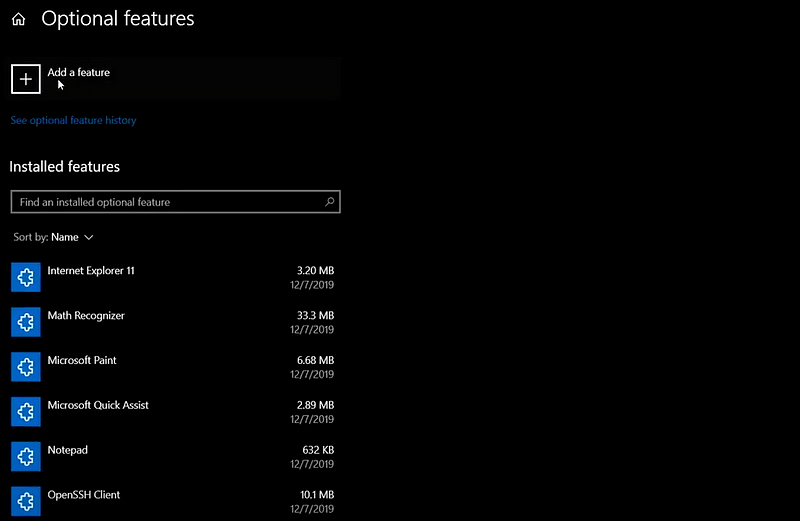
You don’t have to install the whole set of tools. You can selectively choose the tools and install them. For instance, you can choose RSAT: DNS Server Tools and RSAT: DHCP Server tools only and install these. Once the installation is complete, you can go to Windows Administrative Tools to verify if the installation has been successful and see whether the Remote Server Administration Tools are available for use.
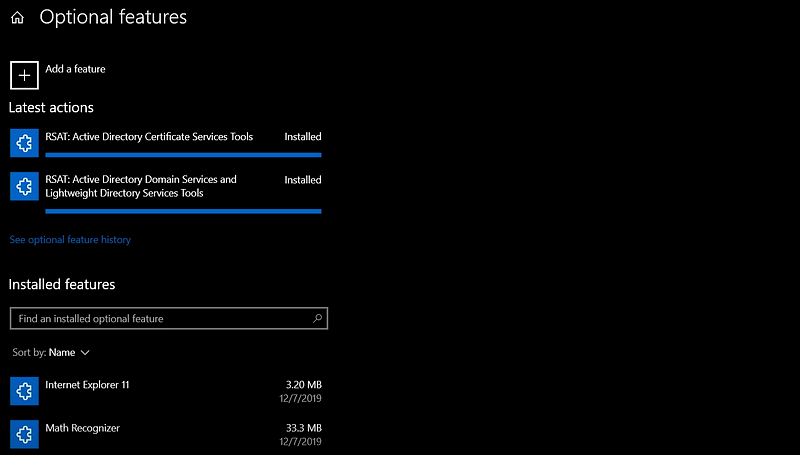
As you can see, the Add a feature button can be used to selectively manage optional features and turn windows features on. These features can range anywhere from active directory domain services to group policy management, and from remote desktop administration to lightweight directory management. You can look into the full list of optional features related to Remote Server Administration Tools in different versions of Windows in the official documentation.
Installing RSAT on Windows 10 using PowerShell
RSAT for Windows 10 can also be installed using the command line, i.e., Windows PowerShell. For power users, using command-line tools is usually a preferable option when compared with the GUI alternative. The fact that the complete installation is scriptable makes this option so attractive to the power users.
Using PowerShell cmdlets to List Administration Tools for Windows
Open a PowerShell terminal and use one of the Windows PowerShell cmdlets called WindowsCapability module to find the list of optional features that contain the phrase RSAT:
Get -WindowsCapability -Online -Name “Rsat*”
Selecting Properties of Optional Features
The above command will list all the properties of the optional feature. The properties include description, capability name, sample package name, satellites, install size, and availability (OS-availability). For instance, let’s look at all the properties listed for the RSAT component used to manage the Remote Access role on Windows Server:
Description: Graphical and PowerShell tools for managing the Remote Access role on Windows ServerDependencies: Rsat.ServerManager.Tools, Rsat.GroupPolicy.Management.ToolsCapability name: Rsat.RemoteAccess.Management.Tools~~~~0.0.1.0Sample package name: Microsoft-Windows-RemoteAccess-Management-Tools-FoD-Package~31bf3856ad364e35~amd64~~.cabSatellites: YesInstall size: 27.70 MBAvailability: Windows 10, version 1809 and later

Reducing Wealth of Properties Output
To reduce the long output list slightly, you can choose to select some of the properties by using the following command:
Get -WindowsCapability -Online -Name “Rsat*” | select name,description | fl
The output of the command above will result in a list that will contain some of the following entries, and more:
Name : Rsat.ActiveDirectory.DS-LDS.Tools~~~~0.0.1.0Description : For remotely managing AD DS and AD LDS on Windows ServerName : Rsat.BitLocker.Recovery.Tools~~~~0.0.1.0Description : Tools for managing BitLocker Drive Encryption FeaturesName : Rsat.Dns.Tools~~~~0.0.1.0Description : DNS MMC snap-in, dnscmd.exe command-line tool, and Windows PowerShell module for DHCP ServerName : Rsat.GroupPolicy.Management.Tools~~~~0.0.1.0Description : Group Policy Management Console, GP Management Editor, and GP Started GPO Editor
Choosing Remote Server Administration Tools Features to Install
Just like in the GUI management console, you can choose the features you want to install. For instance, to install all the features related to RSAT on Windows 10, you can simply run the following command:
Get -WindowsCapability -Online -Name “Rsat*” | Add-WindowsCapability -Online
On the other hand, if you want to be selective and install either a single package or a group of related packages, you can use one of the following commands:
Get -WindowsCapability -Online -Name “Rsat.Dns.Tools~~~~0.0.1.0” | Add-WindowsCapability -OnlineGet -WindowsCapability -Online -Name “Rsat*Dns” | Add-WindowsCapability -Online
Verifying Installed Server Administration Tools Features
Once the installation is done, you can verify the installation by running the following command which lists the installed features:
Get -WindowsCapability -Online -Name “Rsat*” | where -Property state -eq installed | select displayname,name,description
Using PowerShell cmdlets is a simple method to install and verify additional features. Alternatively, you can always go to Windows Administrative Tools and check if the new features have been installed and are visible there.
Ready To Get Going
With the above information in your hand, you should now be able to install RSAT on your own Windows 10 machine using one of the two methods discussed. This will enable you to manage your Windows server effectively from any remote location given you have a stable internet connection.
Are you looking for a dedicated server to run all of this on? Simply contact our team of server experts, who will be more than happy to help you get started.
In the previous versions of Windows, you always had to download and install the Remote Server Administration Tools aka RSAT from Microsoft’s page. Many people complained about the fact that every time you would upgrade to a later build, it would wipe out the tools and you would have to reinstall them. With more recent builds of Windows 10, the remote server administration tools are now part of the build as a Feature and can by accessed by enabling the Feature on Demand. Let’s take a look and install RSAT for Windows 10 Version 1809, 1903 and later using the GUI method as well as using the Powershell method.
Although I much prefer the Powershell method, we’ll start off with the GUI method.
- Open Settings -> Apps -> Optional Features
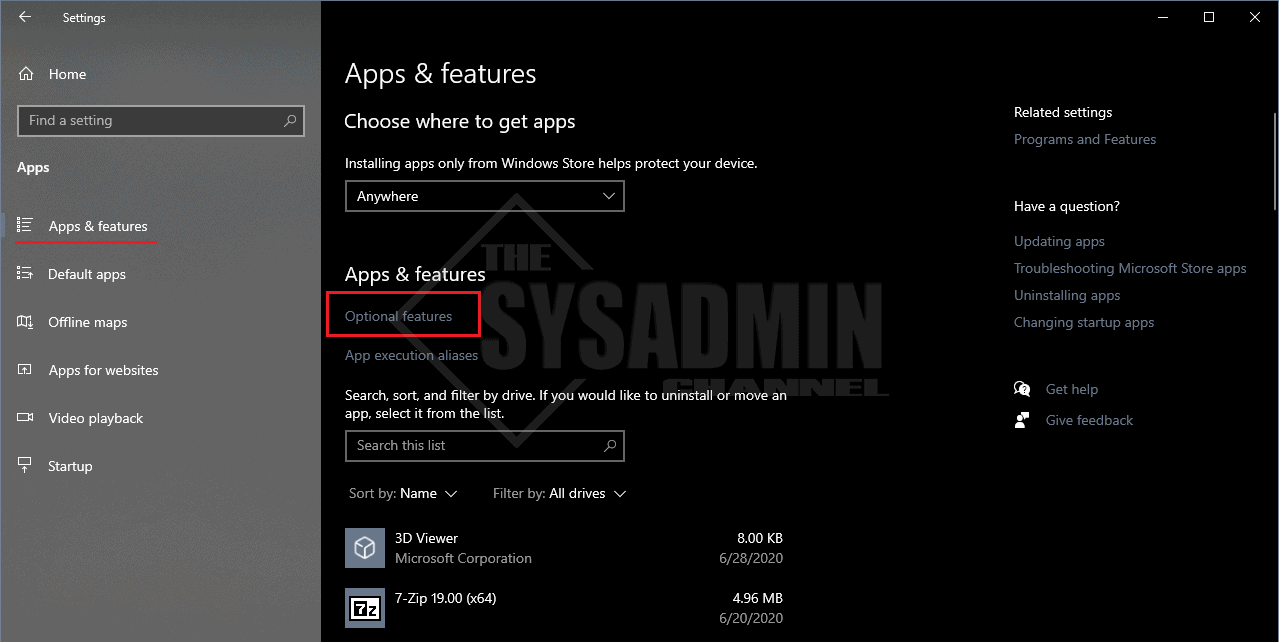
- Select the tools you want to install and click install
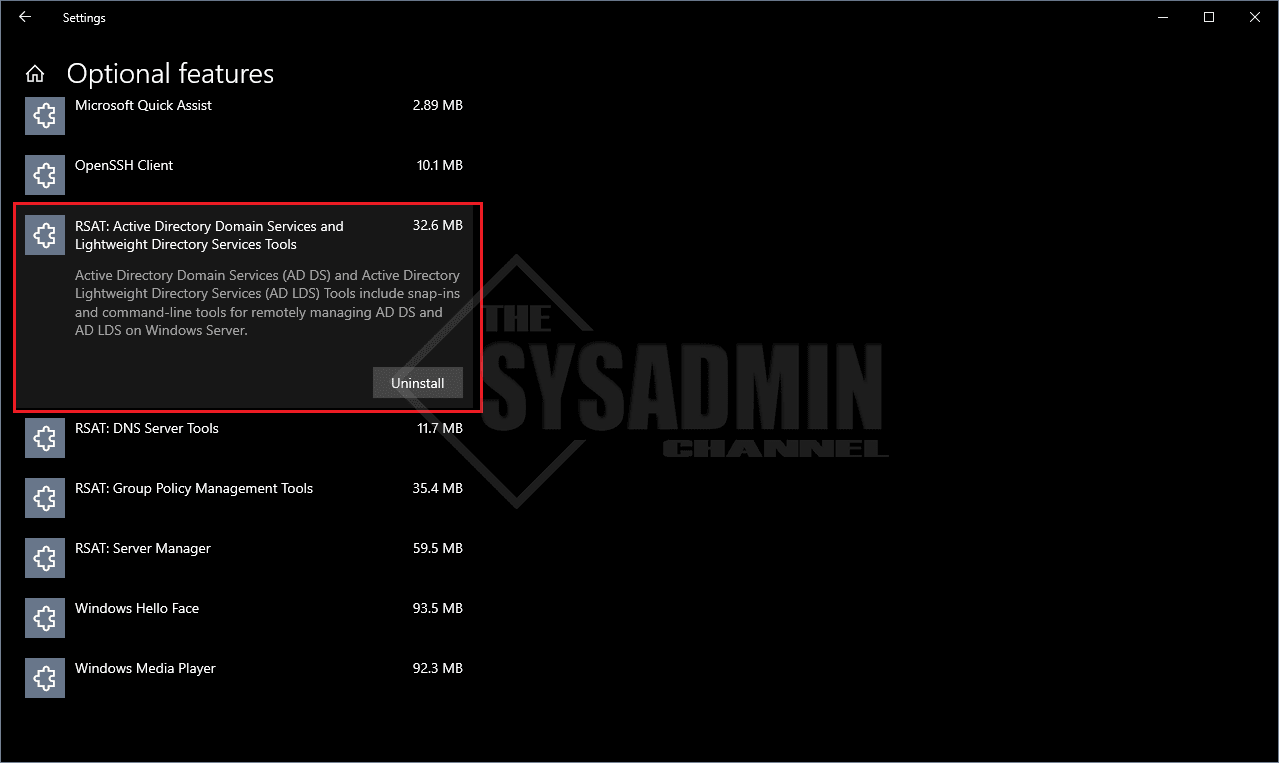
Install RSAT for Windows 10 Version 1809, 1903 and Later in Powershell
- Open Powershell as Administrator
- Type: Get-WindowsCapability -Name RSAT* -Online
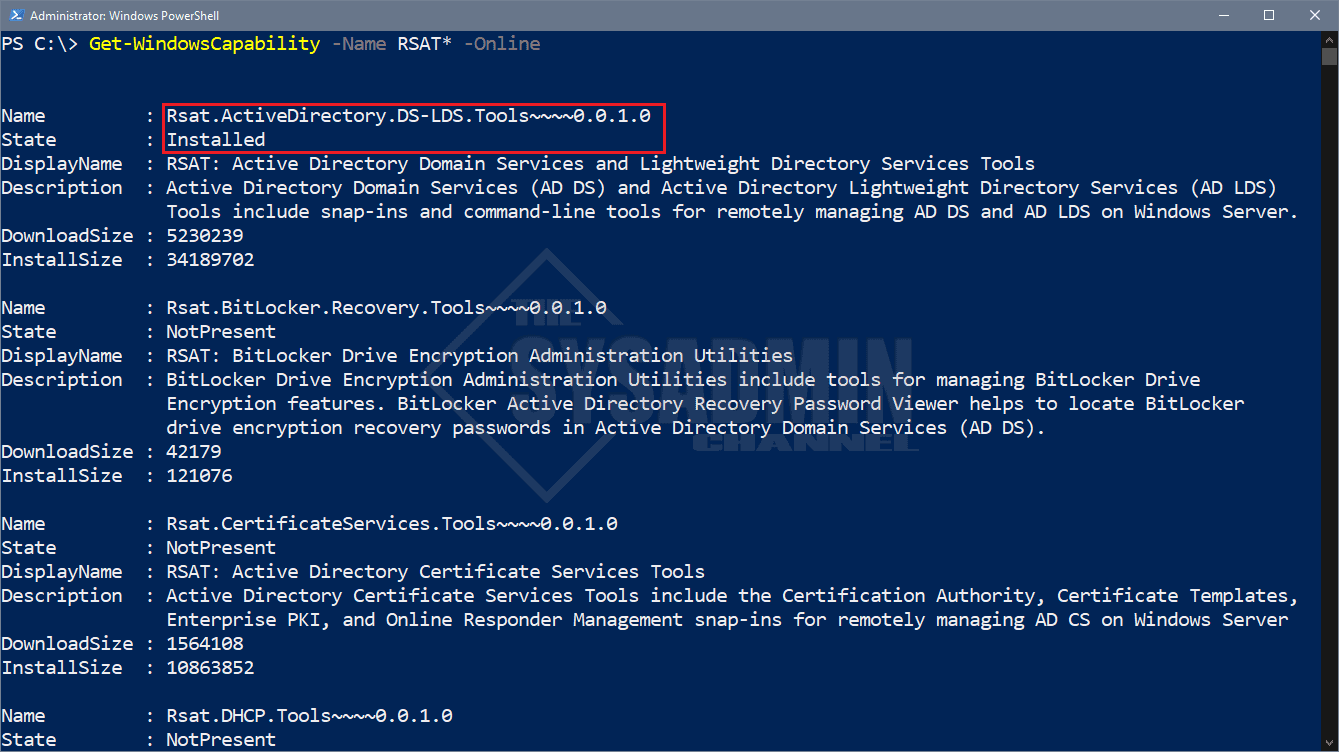
Take note of the name and status
- To install the feature, you can either pipe the command to Add-WindowsCapability -or-
- Add-WindowsCapability -Name Name-of-Feature -Online
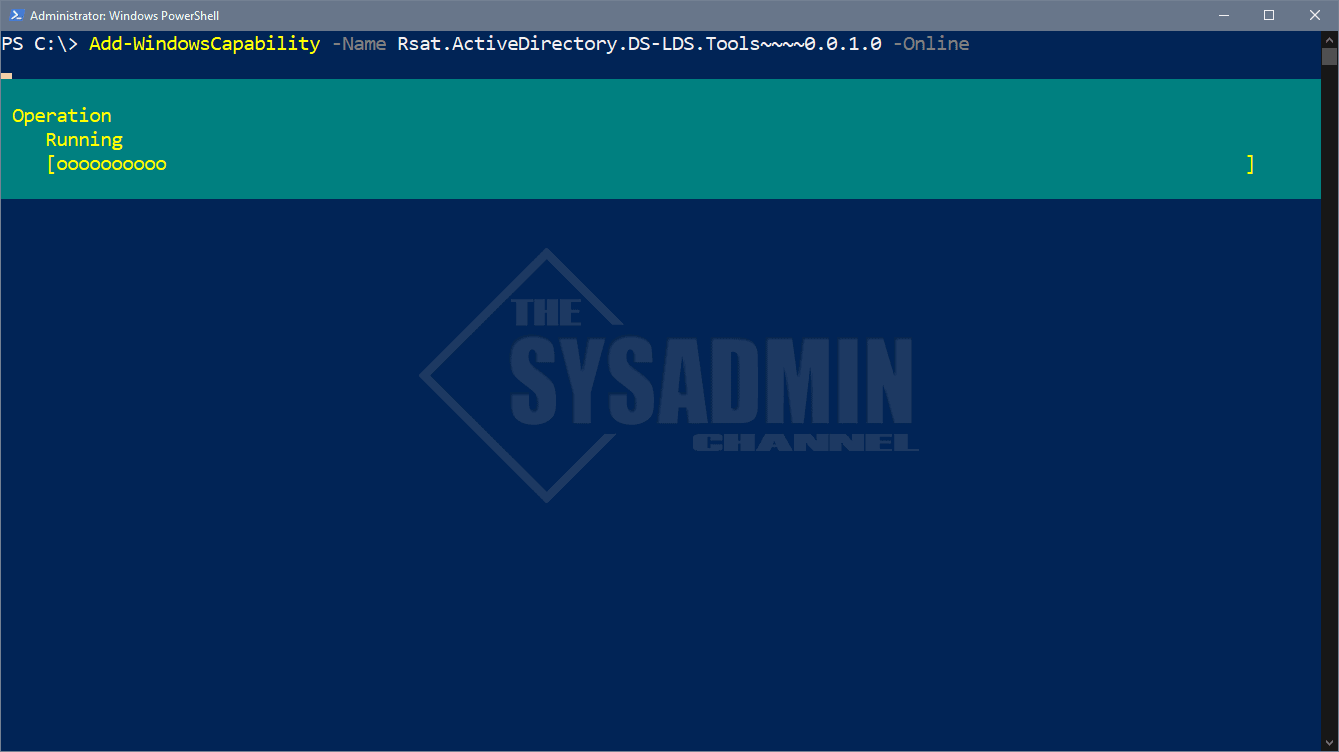
In this example, I’m installing the RSAT: Active Directory Domain Services and Lightweight Directory Services Tools
- The items should now be in the Start Menu -> Windows Administrative Tools
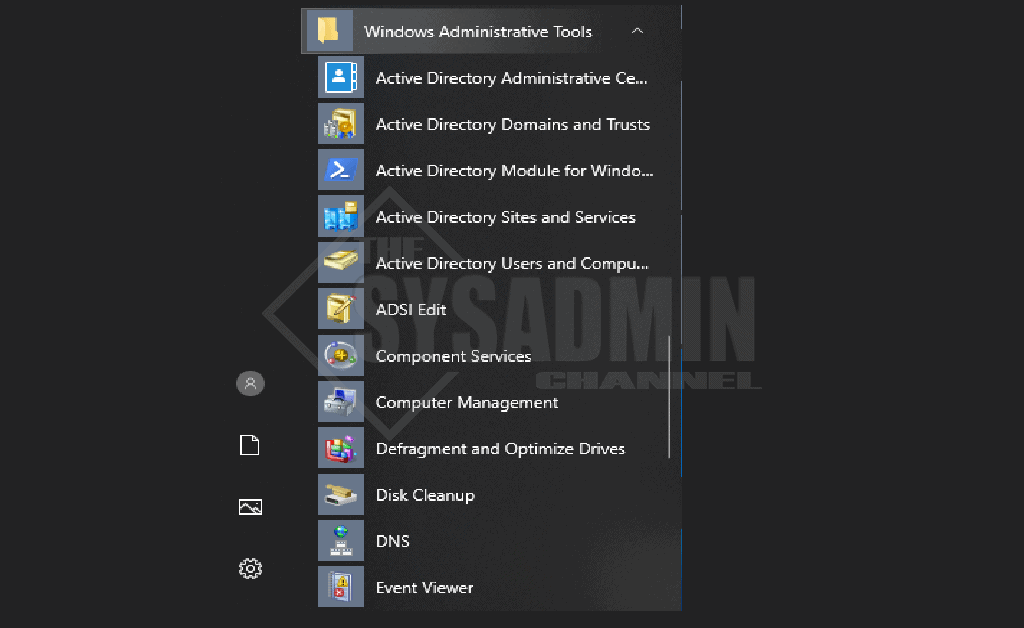
I’d love to hear your feedback and I hope you can now add RSAT easily using the Features on Demand. As always be sure to check out our Youbtube Channel https://www.youtube.com/c/theSysadminChannel or if you want more Server Administration content, check out our Server Administration Category. There is a lot of useful information on both links.
Всем привет.
Набор компонентов RSAT (Remote Server Administration Tools/Средства удаленного администрирования сервера) позволяет удаленно управлять серверными ролями и компонентами на серверах Windows Server с обычной рабочей станции. В RSAT входят как графические MMC оснастки, так и утилиты командной строки, и модули PowerShell. Вы можете установить RSAT как на десктопных версиях Windows 10 или 11, так и на платформе Windows Server. В этой статье мы покажем, как установить RSAT в Windows 10 и Windows 11, и в Windows Server 2022/2019/2022 в онлайн и в офлайн режиме через Feature on Demand из графического интерфейса Windows и через консоль PowerShell.
Обычно советуют ставить RSAT либо через отключение WSUS либо GPO. Можно попробовать для начала установить RSAT с временным отключением WSUS:
$UseWUServer = Get-ItemProperty -Path «HKLM:\SOFTWARE\Policies\Microsoft\Windows\WindowsUpdate\AU» -Name «UseWUServer» | Select-Object -ExpandProperty UseWUServer
Set-ItemProperty -Path «HKLM:\SOFTWARE\Policies\Microsoft\Windows\WindowsUpdate\AU» -Name «UseWUServer» -Value 0
Restart-Service «Windows Update»
Get-WindowsCapability -Name «RSAT*» -Online | Add-WindowsCapability –Online
Set-ItemProperty -Path «HKLM:\SOFTWARE\Policies\Microsoft\Windows\WindowsUpdate\AU» -Name «UseWUServer» -Value $UseWUServer
Restart-Service «Windows Update»
Можно попрoбовать правкой GPO через gpedit.msc:
Computer Configuration > Policies > Administrative Templates >System > Specify settings for optional component installation and component repair:
Set it to Enabled
Alternate source file path: <пусто>
Never attempt to download payload from Windows Update: Disabled
Download repair content and optional features directly from Windows Update instead of Windows Server Update Services (WSUS): Enabled
Get-WindowsCapability -Name «RSAT*» -Online | Add-WindowsCapability –Online
Если при установке RSAT вы столкнетесь с ошибкой Add-WindowsCapability failed. Error code = 0x800f0954, или в списке дополнительных компонентов вы не видите RSAT (Компоненты для установки отсутствуют), скорее всего ваш компьютер настроен на получение обновлений со внутреннего WSUS/SCCM SUP сервера. Если вы не можете открыть прямой доступ с рабочей станции к серверам Windows Update, вы можете воспользоваться офлайн установкой RSAT (рекомендуется для корпоративных сетей без прямого доступа в Интернет).
Вот тут как раз мой случай.
Для оффлайн установки RSAT нужно скачать ISO образ диска с компонентами FoD для вашей версии Windows 10 из вашего личного кабинета на сайте лицензирования Microsoft — Volume Licensing Service Center (VLSC). Образ называется примерно так: Windows 10 Features on Demand, version 1903.
Например, для Windows 11 21Н2 x64 нужно скачать образ SW_DVD9_WIN_11_21H2_X64_MULTILANG_LANGPACKALL_LIP_LOF_X22-62148.ISO и распаковать его в сетевую папку (мой диск «H»). У вас получится набор из множества *.cab файлов, среди которых есть компоненты RSAT в папке LanguagesAndOptionalFeatures:
А дальше просто указываем:
dism /online /enable-feature /featurename:Rsat.ActiveDirectory.DS-LDS.Tools~~~~0.0.1.0 /all /Source:H:\LanguagesAndOptionalFeatures\ /LimitAccess
Или в Powershell:
Add-WindowsCapability –online –Name Rsat.ActiveDirectory.DS-LDS.Tools~~~~0.0.1.0 -LimitAccess -Source H:\LanguagesAndOptionalFeatures\
Если наш образ замаплен через RDP-сессию тогда пишем так:
Add-WindowsCapability –online –Name Rsat.ActiveDirectory.DS-LDS.Tools~~~~0.0.1.0 -LimitAccess -Source \\TSCLIENT\H\LanguagesAndOptionalFeatures\
Проверяем результат:
Get-WindowsCapability –online –Name Rsat.ActiveDirectory.DS-LDS.Tools~~~~0.0.1.0 -LimitAccess
Частые ошибки установки Remote Server Administration Tools в Windows:
- 0x8024402c, 0x80072f8f – Windows не может поучить доступ к серверам обновления Windows для получения компонентов RSAT. Проверьте доступ в интернет или установите компоненты из локального образа FoD: Add-WindowsCapability -Online -Name Rsat.Dns.Tools~~~~0.0.1.0 -LimitAccess -Source E:\RSAT\
- 0x800f081f – проверьте путь к каталогу с компонентами RSAT, указанному в параметре –Source;
- 0x800f0950 – ошибка аналогична 0x800f0954;
- 0x80070490 –проверьте целостность образа Windows с помощью DISM: DISM /Online /Cleanup-Image /RestoreHealth
Успехов.
